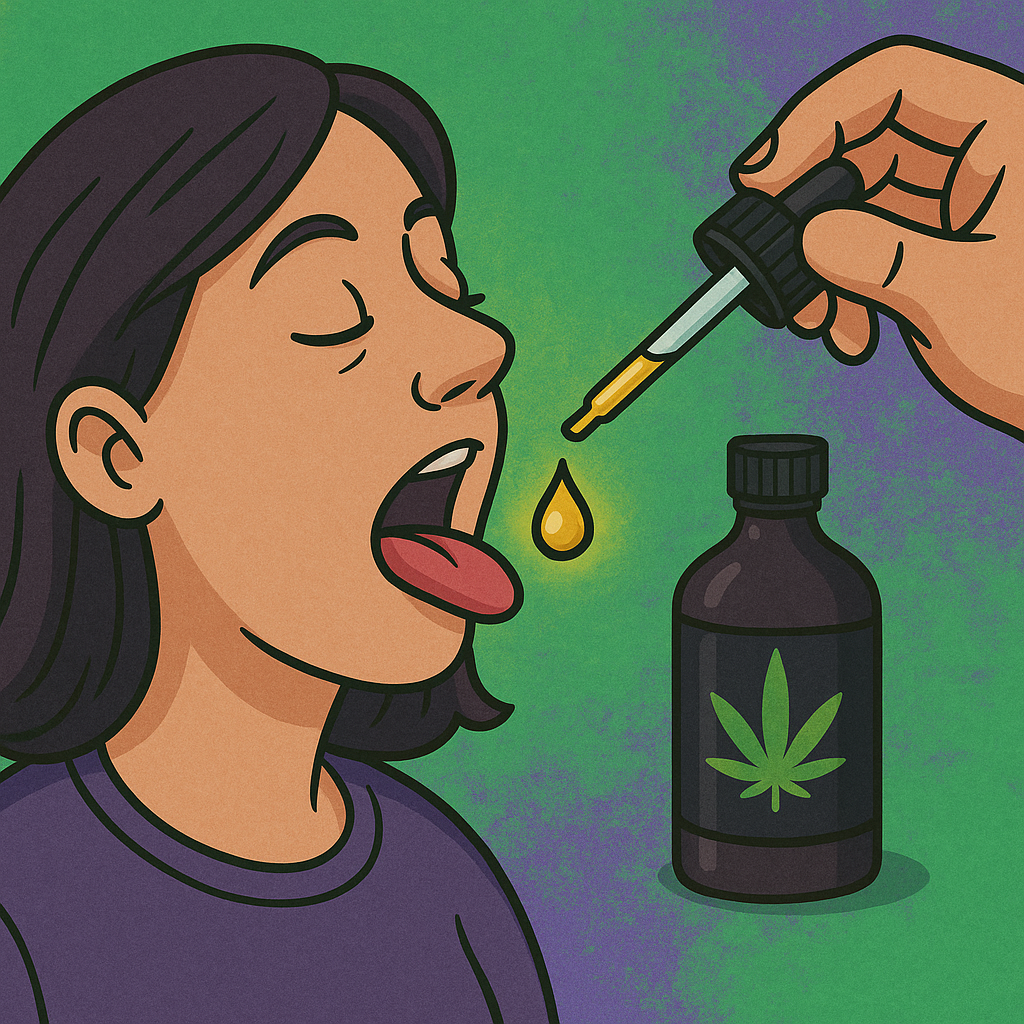Tinctures and Sublingual Use: Precision Dosing with Medical Marijuana
A Balanced Method for Fast and Controlled Relief
Tinctures offer a precise and balanced way to use medical marijuana, providing fast-acting relief with controlled dosing. In the MediWeed Hub, we’re exploring how sublingual use can benefit patients with irie vibes. In this article, we’ll dive deep into the science of tinctures, their advantages for medical use, how they compare to other methods, and practical tips for effective use. Whether you’re managing anxiety, pain, or seizures, tinctures can deliver consistent, customizable effects—let’s explore this versatile method!

Tinctures are liquid cannabis extracts, typically made by soaking cannabis flower in alcohol or a carrier oil (e.g., MCT oil), which extracts cannabinoids like THC and CBD along with terpenes. When used sublingually—by placing drops under the tongue—cannabinoids are absorbed through the mucous membranes in the mouth, entering the bloodstream directly within 15–30 minutes. This bypasses the liver’s first-pass metabolism (unlike edibles), providing faster onset than edibles (30–60 minutes) but longer-lasting effects than inhalation (2–4 hours), with effects lasting 4–6 hours (Lyphe Clinic). A 2017 study in The Journal of Pain found that sublingual THC-CBD tinctures reduced chronic pain by 40% in patients, offering a reliable option for sustained relief.
Sublingual use is particularly advantageous for medical marijuana patients because it allows for precise dosing. Tinctures are typically labeled with exact cannabinoid concentrations—such as 10 mg THC per mL—enabling patients to measure their dose drop by drop using a dropper. This precision is crucial for conditions requiring consistent dosing, such as epilepsy, where a patient might use a CBD tincture (e.g., 10 mg CBD twice daily) to manage seizures without psychoactivity. For example, a patient with anxiety might start with 5 mg CBD under the tongue, wait 30 minutes, and adjust as needed, ensuring they achieve relief without overconsumption (Harvard Health). Tinctures also preserve terpenes like linalool (calming) or limonene (uplifting), enhancing therapeutic effects through the entourage effect.
The versatility of tinctures makes them suitable for a wide range of conditions. THC-dominant tinctures can address pain, nausea, or appetite loss, while CBD-dominant tinctures are ideal for anxiety, seizures, or inflammation without a “high.” Balanced THC-CBD tinctures, such as a 1:1 ratio, offer a mix of effects—pain relief from THC and reduced anxiety from CBD—making them popular for conditions like multiple sclerosis or PTSD. A patient with MS might use a 1:1 tincture (5 mg THC, 5 mg CBD) to reduce spasticity while staying functional during the day. Tinctures can also be swallowed or added to food/drinks, though this delays onset to 30–60 minutes as it goes through digestion, similar to edibles (Mayo Clinic).
Compared to other methods, tinctures strike a balance between speed and duration. Inhalation methods (smoking/vaping) act faster (2–5 minutes) but wear off quickly (2–4 hours), while edibles last longer (6–8 hours) but take longer to kick in (30–60 minutes). Sublingual use provides a middle ground, making it ideal for patients who need both relatively quick relief and sustained effects. For example, a cancer patient might use a THC tincture (2.5 mg) sublingually to manage nausea before a meal, feeling relief within 20 minutes that lasts through the afternoon. Tinctures are also discreet—no smoke or odor—and easy to use on the go, requiring only a small bottle and dropper, which fits easily into a purse or pocket.
Tinctures are a smoke-free option, making them suitable for patients with respiratory issues like asthma or COPD, who may not tolerate inhalation methods. They also avoid the delayed onset and potency variability of edibles, reducing the risk of overconsumption. However, sublingual use can cause a bitter taste or mild irritation under the tongue, especially with alcohol-based tinctures—oil-based tinctures (e.g., MCT oil) are gentler and often flavored with natural extracts like mint or citrus to improve the experience. Patients should hold the tincture under the tongue for 30–60 seconds before swallowing to maximize absorption, as swallowing too quickly sends the dose through digestion, delaying effects (Lyphe Clinic).
Practical considerations for tinctures include starting with a low dose to assess tolerance, as individual responses vary. A typical starting dose might be 2.5 mg THC or 5 mg CBD, with adjustments based on symptom relief and side effects. Tinctures can interact with medications metabolized by the liver—such as antidepressants or blood thinners—if swallowed, so patients should consult a doctor to avoid interactions (Mayo Clinic). Storage is also key—tinctures should be kept in a cool, dark place to preserve potency, as exposure to light or heat can degrade cannabinoids over time. Patients should shake the bottle before use to ensure even distribution of cannabinoids, especially in oil-based tinctures.
Practical Tips
- Start with a Low Dose: Begin with 2.5 mg THC or 5 mg CBD, hold under the tongue for 30–60 seconds, and wait 30 minutes to assess effects before redosing.
- Choose the Right Ratio: Use CBD-dominant tinctures for anxiety or seizures, THC-dominant for pain or nausea, or 1:1 for balanced effects.
- Minimize Discomfort: Opt for oil-based tinctures with flavors like mint to reduce bitterness; rinse your mouth with water if irritation occurs.
- Store Properly: Keep tinctures in a cool, dark place (e.g., a cupboard) to preserve potency, and shake well before each use.
- Track Your Response: Use a journal to note dosage, timing, and effects, sharing with your doctor to fine-tune your regimen.
Key Takeaways
- Tinctures deliver cannabinoids sublingually, with effects starting in 15–30 minutes and lasting 4–6 hours, balancing speed and duration.
- Sublingual use bypasses liver metabolism, offering faster onset than edibles and more precision than inhalation, ideal for conditions like pain or anxiety.
- THC, CBD, or balanced tinctures target specific symptoms—CBD for seizures, THC for nausea, 1:1 for combined effects like MS spasticity relief.
- Tinctures are discreet, smoke-free, and easy to dose, but may cause a bitter taste; oil-based options are gentler and often flavored.
- Start low, store properly, and consult a doctor to avoid interactions, ensuring safe and effective use for medical purposes.













